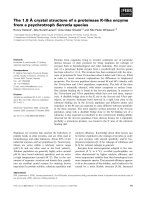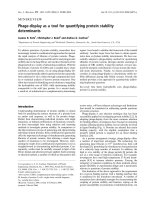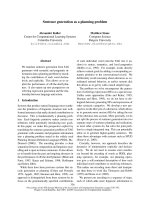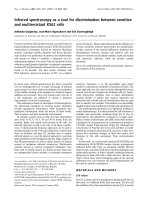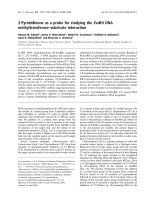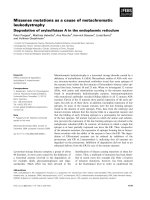Báo cáo khoa học: "Spontaneous pneumothorax as a first sign of pulmonary carcinoma" pdf
Bạn đang xem bản rút gọn của tài liệu. Xem và tải ngay bản đầy đủ của tài liệu tại đây (686.44 KB, 3 trang )
BioMed Central
Page 1 of 3
(page number not for citation purposes)
World Journal of Surgical Oncology
Open Access
Case report
Spontaneous pneumothorax as a first sign of pulmonary carcinoma
Vladislavas Vencevičius*
1
and Saulius Cicėnas
1,2
Address:
1
Department of Thoracic Surgery and Oncology, Institute of Oncology, Vilnius University, Santariškių 1, Vilnius, Lithuania and
2
Vilnius
University, Medical Faculty, Institute of Rehabilitation, Sport Medicine and Nursing, Vilnius, Lithuania
Email: Vladislavas Vencevičius* - ; Saulius Cicėnas -
* Corresponding author
Abstract
Background: Spontaneous pneumothorax (SP) is a rare manifestation of lung cancer. The
mechanisms by which pneumothorax occurs in lung cancer is not clear, resulting in different views
being expressed.
Case presentation: Here we present a case in which pneumothorax occurred as a first
manifestation of lung cancer. The chest x-ray of a 68 year old man revealed a right partial
pneumothorax. VATS was then performed: the visceral pleura lying over segment S
3
was destroyed
and air leaks were found in this section. Pathologic examination of the biopsy specimen revealed
non-small cell carcinoma. Thoracoscopic talc pleurodesis was performed.
Conclusion: Spontaneous pneumothorax in association with lung cancer is rarely seen.
Pneumothorax can be the first sign of lung cancer. The most common possibility for SP
complicating lung cancer is the tumor necrosis mechanism or, in separate cases, rupture of the
emphysematous bullae. Lung cancer should always be considered as a possible cause of SP in elderly
patients or in heavy smokers.
Background
SP is generally attributed to a rupture of the sub-pleural
blebs or emphysematous bullae [1]. This can complicate
primary or secondary lung tumors. SP in primary pulmo-
nary neoplasm or lung metastasis is very rare and the esti-
mated rate of joint occurrence is approximated to be
between 0,03 and 0,05 percent for primary lung cancer [1-
5]. Pneumothorax due to primary lung cancer is also rare
and prognosis is poor because most often the cancer is
either at an advanced stage or the diagnosis of cancer was
delayed [1,5].
Case presentation
A 68 year old man was admitted in September 2007 with
complaints of chest pain, dyspnea and cough in the past 6
days. He was a heavy smoker. Physical examination
revealed tachycardia and tympanic percussion over the
right chest, dullness with decreased breath sounds over
the right lower chest. His chest radiograph of the thorax
showed a lesion in the upper zone of the right lung and
partial pneumothorax (Figures 1, 2).
Routine investigations revealed Hb: 8%, TLC: 9700/
cumm, DLC: P62 L 38 cumin and ERS 20 mm in the first
hour. Blood urea and sugar, etc. were normal. Direct
smear examination of the sputum was negative for acid
fast bacilli as well as malignant cells.
Primary lung carcinoma was suspected. Thorascopy
(VATS) was performed: the visceral pleura lying over seg-
Published: 30 June 2009
World Journal of Surgical Oncology 2009, 7:57 doi:10.1186/1477-7819-7-57
Received: 27 March 2009
Accepted: 30 June 2009
This article is available from: />© 2009 Vencevičius and Cicėnas; licensee BioMed Central Ltd.
This is an Open Access article distributed under the terms of the Creative Commons Attribution License ( />),
which permits unrestricted use, distribution, and reproduction in any medium, provided the original work is properly cited.
World Journal of Surgical Oncology 2009, 7:57 />Page 2 of 3
(page number not for citation purposes)
ment S
3
was destroyed and air leaks were found in this sec-
tion. Histological examination of the biopsy specimen
(S
3
) revealed non-small cell cancer (Figure 3). When
bronchoscopy was performed, compression invasion of
the right upper lobe bronchus was noted, but histological
examination of the bronchoscopic biopsy specimen was
negative (T2 b N0 M 0 stage II A).
Thoracoscopic talc pleurodesis was performed. Chest
drains were removed after 6 days. Because the patient
refused surgery, he then received chemotherapy.
Discussion
Spontaneous pneumothorax is divided into primary and
secondary. Primary SP most commonly afflicts the young
and healthy. The secondary type can develop with
obstruction, infection, infarction, neoplasm and diffuse
lung disease.
SP as a complication of primary lung carcinoma (LC) is
rare [6,7]. It is estimated that only 2% of all SP is coexist-
ent with malignant lung diseases, either primary or sec-
ondary. This tumor complication must be especially
considered in older patients [8].
To date, among the 1200 adults who were found to have
SP from 1970–2007, 37 (3%) had lung cancer. In all such
patients, the pneumothorax occurred in the same side as
the carcinoma. The main cause of SP was the rupture of a
necrotic tumor nodule or necrosis of subpleural metas-
tases (for 21 patients). It also became the communication
cause between the bronchus and pleural cavity, producing
a bronchopleural fistula that resulted in pneumothorax.
We demonstrate that these case reports of lung cancer
with pneumothorax are a rare complication of primary
lung carcinoma.
The mechanism producing pneumothorax from lung can-
cer is not well understood, but a number of theories have
been advanced. The first is that it may be the result of
tumor necrosis – rupture of the necrotic neoplastic tissue
in the pleural cavity [9]; the second, that it may be caused
by the rupture of the necrotic tumor nodule or necrosis of
subpleural metastases [5]. A third is cancer of the check
valve mechanism: the tumor at the lung periphery can
obstruct bronchioles and lead to local overdistention and
Right spontaneous pneumothorax VATS: right S
3
segment granulations in centrally visceral pleura defectFigure 1
Right spontaneous pneumothorax VATS: right S
3
segment granulations in centrally visceral pleura
defect. Biopsy: squamous cell cancer.
Picture shows: after active pleural drainage – lung expendedFigure 2
Picture shows: after active pleural drainage – lung
expended. Right upper lobe: non homogenic infiltration –
tumour.
Publish with BioMed Central and every
scientist can read your work free of charge
"BioMed Central will be the most significant development for
disseminating the results of biomedical research in our lifetime."
Sir Paul Nurse, Cancer Research UK
Your research papers will be:
available free of charge to the entire biomedical community
peer reviewed and published immediately upon acceptance
cited in PubMed and archived on PubMed Central
yours — you keep the copyright
Submit your manuscript here:
/>BioMedcentral
World Journal of Surgical Oncology 2009, 7:57 />Page 3 of 3
(page number not for citation purposes)
rupture of the lung [10]. The fourth is that most patients
with lung cancer have chronic bronchitis or emphysema
bullae and these bullae may rupture following the distur-
bance of the lung architecture due to bronchial cancer
[11].
Pneumothorax related to therapy has been reported in
patients receiving chemotherapy and/or radiotherapy for
lung cancer [12]. There is the possibility that SP and lung
cancer are two independent and incidental processes.
These theories suggest that lung cancer should always be
considered as a possible cause of SP in older patients [13].
Conclusion
Spontaneous pneumothorax in association with lung can-
cer is rarely seen. Pneumothorax can be the first sign of
lung cancer. The most common possibility for SP compli-
cating lung cancer is the tumour necrosis mechanism or,
in separate cases, rupture of the emphysematous bullae.
Lung cancer should always be considered as a possible
cause of SP in elderly patients or in heavy smokers.
Consent
Written informed consent was obtained from the patient
for publication of this case presentation and accompany-
ing images. A copy of the written consent is available for
review by the Editor-in-Chief of this journal.
Competing interests
The authors declare that they have no competing interests.
Authors' contributions
VV wrote the manuscript, sent the specimen to the pathol-
ogist, prepared the material for publication and operated
the patients. SC collected data on a number of patients,
operated on them, treated them and used diagnosis meth-
ods.
References
1. Bauman MH, Noppen M: Pneumothorax. Respirology 2004,
9:157-164.
2. Sahn SA, Heffner JE: Spontaneous pneumothorax. N Engl J Med
2000, 342:868-874.
3. Takashi I, Kiyotoshi I, Ryuhei M, Takuma T, Masaya Y, Shigefumi S:
Acute nonbacterial pleuritis caused by spontaneous rupture
of metastatic pulmonary adenocarcinoma. Gen Thorac 2008,
56:347-350.
4. Smevik B, Klepp O: The risk of spontaneous pneumothorax in
patients with osteogenic sarcoma and testicular cancer. Can-
cer. 1982, 49(8):1734-1737.
5. Steinhäuslin CA, Cuttat JF: Spontaneous pneumothorax. A com-
plications of lung cancer. Ann Thorac Surg 2005, 79:716.
6. Galbis CJM, Mafé MJJ, Baschwitz GB, Pérez CA, Rodríguez PJM:
Spontaneous pneumothorax as the first sign of pulmonary
carcinoma. Arch Bronconeumol 2001, 37(9):397-400.
7. O'Connor BM, Ziegler P, Spaulding MB: Spontaneous pneumoth-
orax in small cell lung cancer. Chest 1992, 102(2):628-629.
8. Pohl D, Herse B, Criée CP, Dalichau H: Spontaneous pneumoth-
orax as the initial symptom of bronchial cancer. Pneumologie
1993, 47(2):69-72.
9. Tsukamoto T, Satoh T, Yamada K, Nagasawa M: Primary lung can-
cer presenting as spontaneous pneumothorax. Nihon Kyobu
Shikkan Gakkai Zasshi 1995, 33(9):936-939.
10. Yeung KY, Bonnet JD: Bronchogenic carcinoma presenting as
spontaneous pneumothorax. Case report with review of lit-
erature. Cancer 1977, 39(5):2286-2289.
11. Okada D, Koizumi K, Haraguchi S, Kawamoto M, Mikami I, Tanaka S:
Pneumothorax manifesting primary lung cancer. J Thorac Car-
diovasc Surg. 2002, 50(3):133-136.
12. Nishioka M, Fukuoka M, Nakagawa K, Matsui K, Nakajima T: Spon-
taneous pneumothorax following partial resolution of total
bronchial obstruction. Chest 1993, 104(1):160-163.
13. Minami H, Sakai S, Watanabe A, Shimokata K: Check-valve mech-
anism as a cause of bilateral spontaneous pneumothorax
complicating bronchioloalveolar cell carcinoma. Chest 1991,
100(3):853-855.
Microview of biopsy specimen H & E stain, × 20 Tumor cellsFigure 3
Microview of biopsy specimen H & E stain, × 20
Tumor cells.

